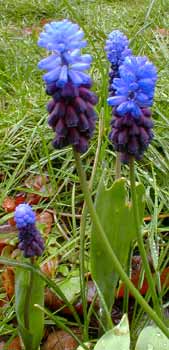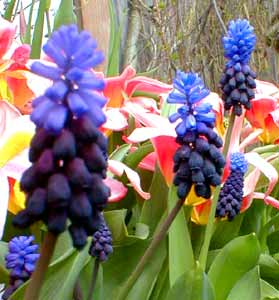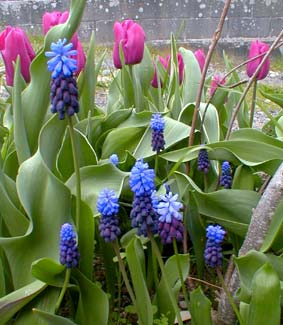
Wide-leaf Grape Hyacinth;
or, Bicolor Muscari
"One blue
grape hyacinth whistles
in the thin and birdless air
without breath. "
 -The End of Your Life,
-The End of Your Life,
by Philip Levine
(born 1928)
 -The End of Your Life,
-The End of Your Life,by Philip Levine
(born 1928)
The leaves of Muscari latifolium are wider than most species of grape hyacinths, much more like lances than the usual grassiness exhibited by the genus overall, or even a bit like diminutive tulip leaves. Bicolor Grape Hyacinths do not produce many of these leaves; sometimes each plant only has one short fat leaf with each flowering stem.
Compared to the usual pyramidal florets of most species of grape hyacinths, the little M. latifolium's florets form a shape that is taller, narrower, & rectacular in their bunch.
The flowers occur on eight to twelve inch stems. They are two-tone, purple over most of its tall slender length, but with a "cap" that is light blue to white. The pale upper flowers are infertile, the dark ones are fertile.
When the leaves first appear in early to mid March, there is already a little blue-purple button of a flower-bud visible from the ground, enfolded in one or rarely two broad leaves.
 The early March (2004) photo, above top right, shows a typical single leaf with a young grape-bunch starting upward within the leaf's embrace. At this young stage the enfolding leaf almost looks like an arum's spathe.
The early March (2004) photo, above top right, shows a typical single leaf with a young grape-bunch starting upward within the leaf's embrace. At this young stage the enfolding leaf almost looks like an arum's spathe.Such a colorful wee bud pushes this muscari's period of interest & color to a considerably earlier date, since there's a touch of blue well before the blooms are full-sized later in March & in April. The stem & bloom soon raise above the leaf, & secondary basal leaves occasionally arrive as the flower matures through the season, but more often extra leaves come from the offsets which when mature enough will have their own spike of grapes.
The Bicolor Muscari that were in full flower in April (2003) lasted clear to June, after which the whole plant died to the ground & was not seen again until the following March. The photo top-left is from late March (2004), take a couple days after the third & lower photo, which shows behind the muscaris some frazzled 'Heart's Delight' Kaufmanniana tulips behind them.
 A single Bicolor Muscari was planted at the base of the front staircase where from one spring to the next it had increased from a single upright flower to three flowers. Fifty more bulbs were planted autumn 2003 over & around three varieties of Kaufmanniana water-lily tulips, which like to have their bulbs planted deeper than the muscaris, so the Kaufmannianas were planted five or six inches deep, & this muscari was inserted two or three inches deep in the same vicinity.
A single Bicolor Muscari was planted at the base of the front staircase where from one spring to the next it had increased from a single upright flower to three flowers. Fifty more bulbs were planted autumn 2003 over & around three varieties of Kaufmanniana water-lily tulips, which like to have their bulbs planted deeper than the muscaris, so the Kaufmannianas were planted five or six inches deep, & this muscari was inserted two or three inches deep in the same vicinity.The waterlily tulips & bicolor muscaris put up their leaves simultaneously & became well-budded together. The tiny muscari buds alongside enormous kaufmanniana buds, in mutually bright colors amidst short fat leaves. The Kaufmannianas are extremely early-blooming for tulips, & appear a little ahead of the biclor muscari, but the muscari's slower-to-mature buds soon join the display. When the Kaufmannianas are wearing out & finall through flowering for the season, the blue muscaris keep color in the spot for many more weeks.
Fifteen more Bicolor Muscari bulbs were planted at the foot of a wisteria, the bulbs being small enough to be dibbled into the thick root system. Obviously it is best to work the soil for new bulbs, but in cases like this where it cannot be done, M. latifolium is tough enough to not mind, & we had so many bulbs it seemed worth trying to get a few of them established in that unusual location, even though it's a spot where the bulbs can never be lifted & divided. At the alley-side of the same sunny garden are Tulipa 'Purple Prince,' & they are shown together in the fourth photo from late March.
M. latifolium is native of pine barrens in Turkey. It likes extremely well-draining moist soil in spring, but almost no water during summer dormancy. It prefers a lot of sun, but will do well even in bright shade. It's amazingly cold hardy, down to minus 30 degrees F., & forgiving of adverse conditions. The bulbs reproduce rapidly by offsets, plus, given its minimal requirements, it naturalizes by self-seeding. The seeds take four years to mature into bulbs that will add further to the number of blooms.